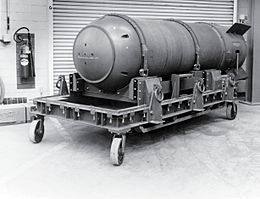1958 Tybee Island mid-air collision facts for kids

A Mk 15 nuclear bomb of the type lost when jettisoned after the collision
|
|
| Midair Collision summary | |
|---|---|
| Date | February 5, 1958 |
| Summary | Midair collision |
| Place | Tybee Island, Georgia, U.S. 32°0′N 80°51′W / 32.000°N 80.850°W |
| First aircraft | |
| Type | Boeing B-47 Stratojet |
| Airline/user | United States Air Force |
| Registration | 51-2349 |
| Fatalities | 0 |
| Second aircraft | |
| Type | F-86 Sabre |
| Airline/user | United States Air Force |
| Crew | 1 |
| Survivors | 1 |
The Tybee Island mid-air collision was an incident on February 5, 1958, in which the United States Air Force lost a 7,600-pound (3,400 kg) Mark 15 nuclear bomb in the waters off Tybee Island near Savannah, Georgia, United States. During a practice exercise, an F-86 fighter plane collided with the B-47 bomber carrying the bomb. To protect the aircrew from a possible detonation in the event of a crash, the bomb was jettisoned. Following several unsuccessful searches, the bomb was presumed lost somewhere in Wassaw Sound off the shores of Tybee Island.
Midair collision
The B-47 bomber was on a simulated combat mission from Homestead Air Force Base in Florida. It was carrying a single 7,600-pound (3,400 kg) bomb. At about 2:00 a.m., an F-86 fighter collided with the B-47. The F-86 crashed after the pilot ejected from the plane. The damaged B-47 remained airborne, plummeting 18,000 feet (5,500 m) from 38,000 feet (12,000 m) when the pilot, Colonel Howard Richardson, regained flight control.
The crew requested permission to jettison the bomb, in order to reduce weight and prevent the bomb from exploding during an emergency landing. Permission was granted, and the bomb was jettisoned at 7,200 feet (2,200 m) while the bomber was traveling at about 200 knots (370 km/h). The crew did not see an explosion when the bomb struck the sea. They managed to land the B-47 safely at the nearest base, Hunter Air Force Base. Colonel Richardson was awarded the Distinguished Flying Cross after this incident.
The bomb
Some sources describe the bomb as a functional nuclear weapon, but others describe it as disabled. If it had a plutonium nuclear core installed, it was a fully functional weapon. If it had a dummy core installed, it was incapable of producing a nuclear explosion but could still produce a conventional explosion. The 12-foot (4 m) long Mark 15 bomb weighs 7,600 pounds (3,400 kg) and bears the serial number 47782. It contains 400 pounds (180 kg) of conventional high explosives and highly enriched uranium. The Air Force maintains that its "nuclear capsule" (physics package), used to initiate the nuclear reaction, was removed before its flight aboard the B-47. As noted in the Atomic Energy Commission "Form AL-569 Temporary Custodian Receipt (for maneuvers)", signed by the aircraft commander, the bomb contained a simulated 150-pound (68 kg) cap made of lead. However, according to 1966 Congressional testimony by Assistant Secretary of Defense W.J. Howard, the Tybee Island bomb was a "complete weapon, a bomb with a nuclear capsule" and one of two weapons lost that contained a plutonium trigger. Nevertheless, a study of the Strategic Air Command documents indicates that Alert Force test flights in February 1958 with the older Mark 15 payloads were not authorized to fly with nuclear capsules on board. Such approval was pending deployment of safer "sealed-pit nuclear capsule" weapons, which did not begin deployment until June 1958.
Recovery efforts
Starting on February 6, 1958, the Air Force 2700th Explosive Ordnance Disposal Squadron and 100 Navy personnel equipped with hand-held sonar and galvanic drag and cable sweeps mounted a search. On April 16, the military announced the search had been unsuccessful. Based on a hydrologic survey, the bomb was thought by the Department of Energy to lie buried under 5 to 15 feet (1.5 to 4.6 m) of silt at the bottom of Wassaw Sound.
In 2004, retired Air Force Lt. Colonel Derek Duke claimed to have narrowed the possible resting spot of the bomb down to a small area approximately the size of a football field. He and his partner located the area by trawling in their boat with a Geiger counter in tow. Secondary radioactive particles four times naturally occurring levels were detected and mapped, and the site of radiation origination triangulated. An Air Force nuclear weapons adviser speculated that the source of the radiation was natural, originating from monazite deposits.
Ongoing concerns
As of 2007, no undue levels of unnatural radioactive contamination have been detected in the regional Upper Floridan aquifer by the Georgia Department of Natural Resources (over and above the already high levels thought to be due to monazite, a locally occurring mineral that is naturally radioactive).
In popular culture
In February 2015, a fake news web site ran an article stating that the bomb was found by vacationing Canadian divers and that the bomb had since been removed from the bay. The fake story spread widely via social media.

